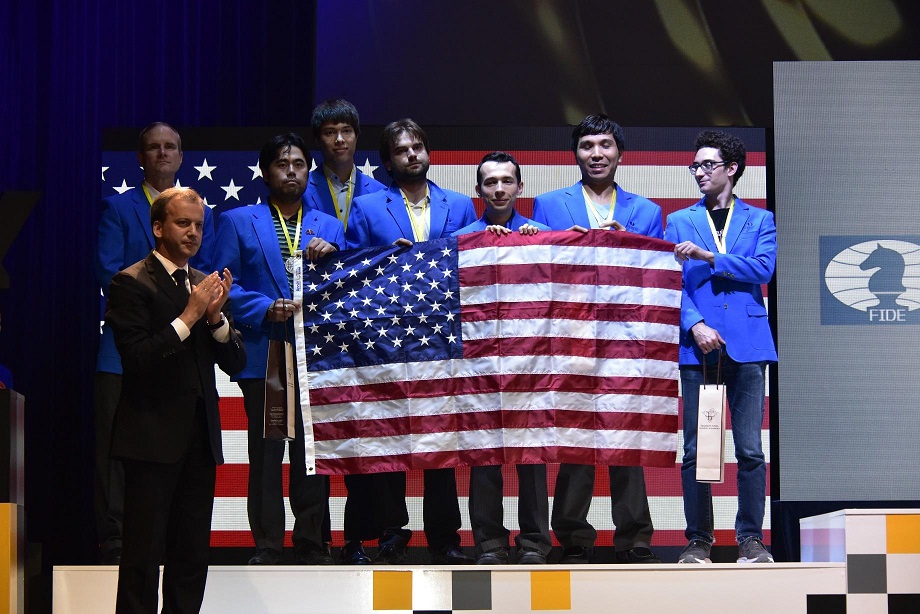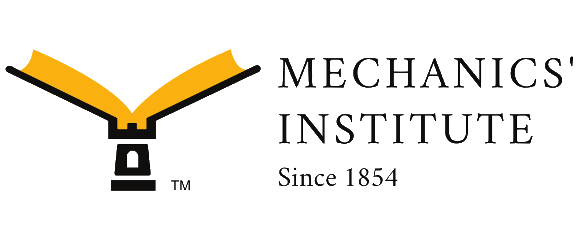Gens Una Sumus!
Mechanics’ Institute Chess Club Newsletter #848
November 9, 2018
I think he still has a long way to go when it comes to experience and understanding, but he makes up for a lot of it by being very energetic and extremely optimistic as well. It’s always interesting to watch his games because he always goes for it, he never plays for a draw.
—Magnus Carlsen, talking about Jan-Krzysztof Duda.
The Polish grandmaster is currently the top-rated player
in the world under 21 at 2735 (number 20 in the world).
See Carlsen's commentary on round seven of the Batumi Olympiad.
1) Mechanics’ Institute Chess Club News
After three rounds there are seven players with perfect scores in the Vartan Bedjanian Memorial Tuesday Night Marathon, led by FIDE Master Ezra Chambers. It is still possible to join the country’s largest weekly tournament with half-point byes in rounds 1–3.
From round 3 of the Vartan Bedjanian Tuesday Night Marathon:
| White to move (Uribe–Fuentes after 21...Kf7) | White to move (Boldi–Cendejas after 25...Re4) |
| White to move (Wong–Agdamag after 38...f4) | White to move (Pham–Revi after 33...Nxe4) |
| White to move (Cohee–Bentz after 27...Rb8) | White to move (Furukawa–Abdi after 44...Qe7) |
| Black to move (Olson–Starr after 45 Kxh3) | For the solutions, see the game scores for round 3. |
Carlos Davila took first place in the November 7 edition of the Wednesday Night Blitz. Second was Sunjay Somani, third, Jules Jelinek.
Tying for first place in the 47th Carroll Capps Memorial, held on November 3–4 at the Mechanics’ Institute, were National Master Mike Arne, Expert Ethan Boldi, and Class A player Cailen Melville.
Melville went on a tear, winning four in a row and defeating Masters Romulo Fuentes and Paul Gallegos as well as Boldi on the way, before taking byes in the last two rounds.
The 26-player event was directed by Bryon Doyle.
2) Eric Andrew Schiller (1955–2018)
Caissa has had few supporters as devoted as FIDE Master Eric Schiller, who passed away on November 3, 2018, in San Jose. The case of death was cardiovascular disease after a long wasting illness.
Schiller was introduced to the game at the age of four and a half, but didn’t start playing tournament chess until he was 14. That didn’t stop him from becoming a FIDE Master and USCF Life Master, nor from becoming one of the most prolific authors in chess history.
Born and raised in New York City, Schiller moved in his late teens to study at the University of Chicago, where he earned an undergraduate degree in German, a Master’s in Russian and a PhD in Linguistics. He also pursued a career as a music conductor, but in the end his love of chess won out.
When the Soviet team attended the 1981 World Student Team Championship in Graz, Austria, without a translator it was U.S. Team Captain Eric Schiller who became their go-between with the organizers. This led to his becoming Garry Kasparov’s right-hand man in the West for several years.
Schiller will be remembered for organizing more than two dozen norm tournaments, starting in the late 1970s and continuing to the late 1990s, with the 1983 World Student Team Championship in Chicago and the 1998 U.S. Open in Kona, Hawaii, the highlights. The latter, won by Judit Polgar and Boris Gulko, was not a financial success, but well remembered as a great event. Eric was a man of vision with many interesting ideas.
He will also be remembered by the many students he taught. Even when diabetes had taken an arm and a leg, he never gave up his teaching, showing incredible resilience. Eric Schiller will be remembered.
3) Excellent Result but Missed Opportunities: Batumi 2018
The United States finished in a three-way tie for first in the recent Chess Olympiad, finishing second behind China on tiebreak. The Americans faced tougher opposition than in 2016, defeating top-ten teams Azerbaijan, India and Armenia, plus Netherlands (#13) and Croatia (#18), but a drawn match with Israel and particularly a loss to Poland proved costly. In both these matches the U.S. had excellent chances to win (against the latter 3½–½ was possible), but failed to capitalize on favorable positions.
Finishing second when six teams averaged over 2700 FIDE can never be bad, but it is an indication of how far American chess has advanced the past decade that the result was ever-so-slightly disappointing.

U.S. team receiving their silver medals in Batumi. L–R John Donaldson (captain), Arkady Dvorkevich (FIDE President), Hikaru Nakamura, Ray Robson, Sam Shankland, Alex Lenderman (coach), Wesley So and Fabiano Caruana. (Photo: U.S. Chess)
The team the U.S. fielded in Batumi was definitely stronger than that for the previous Olympiad in Baku, with Sam Shankland of Walnut Creek having transformed himself into a world top-25 player (2680 to 2725) the past two years. He had an excellent result with 7 out of 10, despite having the white pieces only four times. His result included clutch victories with Black over Rauf Mamedov and Hrant Melkumyan. Sam just missed an individual medal, with the fourth-best result on board 4.
4) Petrosian before he was Petrosian
Gideon Stahlberg (1908–1967) of Sweden was one of the great players of the 1930s, defeating Aron Nimzowitsch and Rudolf Spielmann and drawing Paul Keres in matches that decade. Arguably his best-ever tournament result was tying for sixth in the 1948 Interzonal, which qualified him for the 1950 Candidates’, where he scored a very respectable 8 from 18. Stahlberg also has the distinction of serving as the chief arbiter for five world championship matches.
Tigran Petrosian had already placed second in the 1951 Soviet Championship when the following game was played in the Geza Maroczy Memorial. Here the Swede completely outplays his younger rival, masterfully combining strategy and tactics in a way Petrosian would soon be known for.
We thank National Master Fred Wilson, the noted chess book dealer, teacher and author, for bringing this game to our attention.
Blumenfeld A43
Gideon Stahlberg–Tigran Petrosian
Budapest 1952
1.d4 Nf6 2.Nf3 c5 3.d5 b5 4.Bg5 Qa5+?!
Today 4...Qb6 and 4...Ne4 are Black’s most popular tries.
5.c3 Ne4
6.Nbd2!
White offers the bishop pair for a lead in development.
6...Nxg5 7.Nxg5 h6 8.Ngf3 d6
8...g6 was more flexible.
9.e4 Nd7
9...g6 is too slow now: 10.a4 b4 11.Bb5+ Bd7 12.Nc4 Qc7 13.cxb4 cxb4 14.Qd4 and White is well on his way to winning the game.
10.a4!
The classic break against the Blumenfeld.
10...bxa4
As 10...b4 is strongly met by 11.cxb4 cxb4 12.Bb5 with Nc4 and e5 to follow.
11.Rxa4 Qc7 12.Qa1! Nb6
12...g6 13.Bb5 Bg7 14.Bc6 and the a-pawn falls.
13.Bb5+ Bd7 14.Bxd7+ Qxd7
15.Ra6!
The threat of Rxb6 stops Black from having time to develop his kingside.
15...Nc8 16.0–0 e5
Unfortunately necessary as 16...g6 is countered by 17.b4! with the point that 17...Bg7 is met by 18.bxc5 dxc5 19.Qa3 0–0 and now both the material approach 20.Qxc5 and positional squeeze 20.Rb1 , are strong.
17.dxe6 fxe6 18.Nh4!
The start of operations on the other flank spells Black’s doom.
18...Kf7 19.f4 Qd8 20.Nhf3 Qe8 21.f5! exf5 22.Qa2+ Qe6
23.Ne5+!! Ke7 24.Nc6+ Kd7 25.Qa4! Ke8
25...Kc7 26.Qa5+ Nb6 27.Nxa7.
26.exf5 Qe3+ 27.Kh1 1–0
5) Perfect Christmas Present for a Chess Player
The Sinquefield Cup: Celebrating Five Years. 2013-2017 is one of the biggest, heaviest and most beautiful chess books ever produced. The oversize, 334-page hardcover book is printed on high quality paper, the better to show off over 200 color and black-and-white photos taken by some of the best in the business, including the legendary Harry Benson. Lots of color and high-quality annotations to the most important games from the five elite events featuring world class players round out an impressive work. This book, which can only be purchased here, is available for $50 plus postage (varying by location but roughly $20 for two-day UPS service for the seven pound book). Copies autographed by the participants are also available for purchase.
6) Viktors Pupols has done it again
Rusty Miller reports the 2018 Washington Challenger’s Cup took place October 27–28 at the Seattle Chess Club and attracted 61 players in two sections. FIDE Master Steven Breckenridge from Gresham, Oregon, won the open section for the second year in a row with a perfect 4/4 and took home the $600 first-place prize. Two Washington masters tied for second with 3½/4: National Masters Viktors Pupols from Kingston and Harley Greninger from Hoquiam. By virtue of having the highest tiebreaks, Viktors is seeded into the 2019 WA State Championship.
Pupols, who turned 84 this past summer, played in his first Washington State Championship in 1954.
7) This is the end
In this study, Black is attacking two of White’s pieces. Is there a way out?
White to move
Show solution
You can browse through our archived newsletters using the "next" and "previous buttons".
Want to save this newsletter for reading at a later time? Click here to learn how.
Want to be notified when the next newsletter is published? Join Our Email List →
